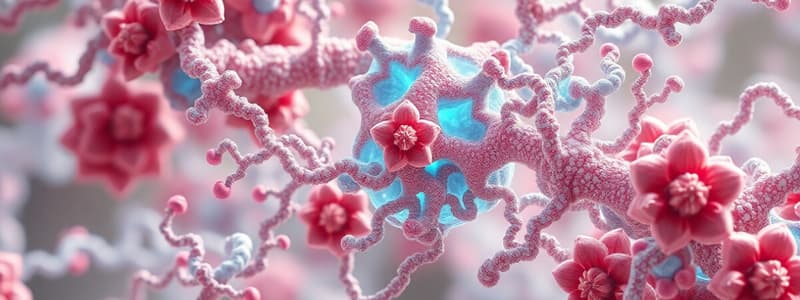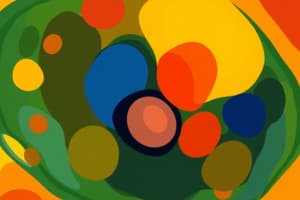Podcast
Questions and Answers
What triggers the denaturation of proteins?
What triggers the denaturation of proteins?
- Increased concentration of salts
- Changes in pH levels (correct)
- Exposure to low temperatures
- High oxygen levels
Which component contributes the majority to the composition of plasma?
Which component contributes the majority to the composition of plasma?
- Proteins
- Organic compounds
- Water (correct)
- Lipids
After denaturation, which of the following statements is true about some proteins?
After denaturation, which of the following statements is true about some proteins?
- They immediately regain their function.
- They can never regain their structure.
- They can refold if denaturants are removed. (correct)
- They become completely inactive.
What defines a protein according to its amino acid chain length?
What defines a protein according to its amino acid chain length?
What primarily holds the information necessary for a protein's 3D structure?
What primarily holds the information necessary for a protein's 3D structure?
Which type of protein is typically found in plasma?
Which type of protein is typically found in plasma?
Which of these is NOT a consequence of protein denaturation?
Which of these is NOT a consequence of protein denaturation?
Which statement about the linear sequence of amino acids in a protein is accurate?
Which statement about the linear sequence of amino acids in a protein is accurate?
What is the implication of finding Type II proteins in plasma?
What is the implication of finding Type II proteins in plasma?
What was the significance of insulin in protein structure research?
What was the significance of insulin in protein structure research?
What primary technique is used to separate plasma proteins for diagnostic analysis?
What primary technique is used to separate plasma proteins for diagnostic analysis?
What is the role of molecular chaperones in protein functionality?
What is the role of molecular chaperones in protein functionality?
How can disease conditions potentially be detected through plasma proteins?
How can disease conditions potentially be detected through plasma proteins?
Why is the folding of proteins crucial for their functionality?
Why is the folding of proteins crucial for their functionality?
What type of interaction occurs between subunits of plasma proteins in the context provided?
What type of interaction occurs between subunits of plasma proteins in the context provided?
What is the primary building block of proteins?
What is the primary building block of proteins?
How many amino acids contribute to the formation of proteins?
How many amino acids contribute to the formation of proteins?
What type of bond forms between the α-carboxylic and α-amino groups of amino acids?
What type of bond forms between the α-carboxylic and α-amino groups of amino acids?
In which animal groups does albumin predominate over globulin?
In which animal groups does albumin predominate over globulin?
Why are newborn animals, excluding primates and rodents, more susceptible to infections?
Why are newborn animals, excluding primates and rodents, more susceptible to infections?
What are peptides primarily composed of?
What are peptides primarily composed of?
How is the albumin-to-globulin ratio typically characterized in most animals?
How is the albumin-to-globulin ratio typically characterized in most animals?
Which of the following describes the properties of plasma proteins in animals?
Which of the following describes the properties of plasma proteins in animals?
What role do secondary structures play in protein architecture?
What role do secondary structures play in protein architecture?
What is the significance of GGT in medical diagnostics?
What is the significance of GGT in medical diagnostics?
How do hydrophobic interactions affect protein structure?
How do hydrophobic interactions affect protein structure?
Which enzyme is associated with muscle and bone diseases?
Which enzyme is associated with muscle and bone diseases?
What is the relationship between ionizable residues and protein structure?
What is the relationship between ionizable residues and protein structure?
What characterizes the α-helix structure in proteins?
What characterizes the α-helix structure in proteins?
Which of the following enzymes is used as a marker for liver and heart diseases?
Which of the following enzymes is used as a marker for liver and heart diseases?
What determines the folding of β-sheets in proteins?
What determines the folding of β-sheets in proteins?
What type of interaction primarily influences the folding and stability of protein structures?
What type of interaction primarily influences the folding and stability of protein structures?
What stabilizes the tertiary structure of a protein?
What stabilizes the tertiary structure of a protein?
What can be a consequence of decreased albumin levels in the blood?
What can be a consequence of decreased albumin levels in the blood?
Which structure describes how multiple protein subunits assemble into a complex?
Which structure describes how multiple protein subunits assemble into a complex?
Which of the following interactions is NOT involved in stabilizing the tertiary structure of proteins?
Which of the following interactions is NOT involved in stabilizing the tertiary structure of proteins?
What is one of the key functions of albumin in the blood?
What is one of the key functions of albumin in the blood?
The tertiary structure of a protein involves interactions that occur between which parts?
The tertiary structure of a protein involves interactions that occur between which parts?
Which type of bond is specifically involved in the formation of disulfide bridges in proteins?
Which type of bond is specifically involved in the formation of disulfide bridges in proteins?
What effect does albumin have on bilirubin levels in the bloodstream?
What effect does albumin have on bilirubin levels in the bloodstream?
In the context of protein structure, what does the term 'electrostatic interactions' refer to?
In the context of protein structure, what does the term 'electrostatic interactions' refer to?
What is the primary distinguishing factor between tertiary and quaternary protein structures?
What is the primary distinguishing factor between tertiary and quaternary protein structures?
Flashcards
Polypeptide Chain Definition?
Polypeptide Chain Definition?
A protein is considered a polypeptide chain if it has more than 50 amino acids.
What are proteins?
What are proteins?
Proteins serve as biological catalysts that speed up chemical reactions in our bodies.
Primary Structure
Primary Structure
The primary structure of a protein refers to the specific sequence of amino acids in a chain. It's like a blueprint of a protein.
Protein Structure: Chains?
Protein Structure: Chains?
Signup and view all the flashcards
Type I and Type II Proteins
Type I and Type II Proteins
Signup and view all the flashcards
Electrophoretic Analysis
Electrophoretic Analysis
Signup and view all the flashcards
Molecular Chaperones
Molecular Chaperones
Signup and view all the flashcards
Protein Folding
Protein Folding
Signup and view all the flashcards
Plasma Protein Distribution
Plasma Protein Distribution
Signup and view all the flashcards
Electrophoresis for Disease Detection
Electrophoresis for Disease Detection
Signup and view all the flashcards
Proteins
Proteins
Signup and view all the flashcards
Amino Acids
Amino Acids
Signup and view all the flashcards
Amino Acid Variety
Amino Acid Variety
Signup and view all the flashcards
Peptide Bond
Peptide Bond
Signup and view all the flashcards
Peptides
Peptides
Signup and view all the flashcards
Albumin
Albumin
Signup and view all the flashcards
Globulins
Globulins
Signup and view all the flashcards
Albumin-to-Globulin Ratio
Albumin-to-Globulin Ratio
Signup and view all the flashcards
Denatured state
Denatured state
Signup and view all the flashcards
Denaturants
Denaturants
Signup and view all the flashcards
Denaturation
Denaturation
Signup and view all the flashcards
Refolding
Refolding
Signup and view all the flashcards
Amino acid sequence determines 3D structure
Amino acid sequence determines 3D structure
Signup and view all the flashcards
Tertiary structure
Tertiary structure
Signup and view all the flashcards
Secondary structure
Secondary structure
Signup and view all the flashcards
Quaternary structure
Quaternary structure
Signup and view all the flashcards
Disulfide bridges
Disulfide bridges
Signup and view all the flashcards
Electrostatic interactions
Electrostatic interactions
Signup and view all the flashcards
Hydrogen bonds
Hydrogen bonds
Signup and view all the flashcards
Hydrophobic interactions
Hydrophobic interactions
Signup and view all the flashcards
Edema
Edema
Signup and view all the flashcards
α-helix
α-helix
Signup and view all the flashcards
β-sheet
β-sheet
Signup and view all the flashcards
Common structure
Common structure
Signup and view all the flashcards
GGT (γ-glutamyl transferase)
GGT (γ-glutamyl transferase)
Signup and view all the flashcards
CK (creatine kinase)
CK (creatine kinase)
Signup and view all the flashcards
ALT (Alanine aminotransferase)
ALT (Alanine aminotransferase)
Signup and view all the flashcards
AST (Aspartate aminotransferase)
AST (Aspartate aminotransferase)
Signup and view all the flashcards
Ionizable residues
Ionizable residues
Signup and view all the flashcards
Study Notes
Plasma Proteins
- Plasma proteins are polymers of amino acids
- Only 20 amino acids make up proteins
- Peptide bonds link amino acids, forming long chains
- Chains exceeding 50 amino acids are proteins, potentially single or multiple polypeptide chains
- Protein structure is critical to function:
- Primary structure: linear sequence of amino acids
- Secondary structure: spatial arrangement due to hydrogen bonds (e.g., alpha-helix, beta-sheet)
- Tertiary structure: full 3D structure of a protein
- Quaternary structure: organization of multiple subunits
- Protein folding:
- Native conformation: stable, functional protein folding
- Misfolding: dysfunctional proteins and disease potential (e.g., amyloid fibers in Alzheimer's and Parkinson's)
- Types of proteins:
- Simple proteins (holoproteins): composed only of amino acids
- Conjugated proteins (heteroproteins): contain a protein part (apoprotein) and a non-protein part (prosthetic group)
- Globular proteins: spherical, water-soluble (e.g., enzymes, hemoglobin)
- Fibrous proteins: long, insoluble, form structural frameworks (e.g., collagen, keratin)
Plasma Protein Functions
- Regulation of osmotic pressure: primarily by albumin
- Transport of molecules: hormones, lipids, vitamins
- Immune response: immunoglobulins fight infections
- Blood clotting: clotting factors (e.g., fibrinogen)
- Hormone activity
- Enzymatic: catalyze reactions
- Buffering: maintains blood pH (7.4)
- Amino acid source: broken down for tissue synthesis
Plasma Protein Types
- Albumin: predominant in horses, cows, dogs, and cats; important for osmotic pressure.
- Globulins: varying ratios across species. Newborn animals, except primates and rodents, lack significant gamma globulin at birth.
- Type I Globulins: Normally found in plasma
- Type II Globulins: Present in plasma in disease situations
Enzyme Markers
-
Elevated levels of certain enzymes in the blood (e.g., ALP, GGT, CK, ALT, AST) are indicators of various diseases (e.g., bone, liver, muscle, heart diseases).
-
Enzyme levels indicate tissue damage, synthesis rate of enzymes, delivery rate to the blood, and factors that inactivate or remove enzymes
-
Electrophoretic analysis: Method to separate plasma proteins, aiding diagnosing diseases by looking at the different patterns. Protein distribution changes with infection, injury, or inflammation.
-
Plasma composition: 92% water; remains composed of 7% of plasma protein concentration along with organic, inorganic compounds.
Studying That Suits You
Use AI to generate personalized quizzes and flashcards to suit your learning preferences.




